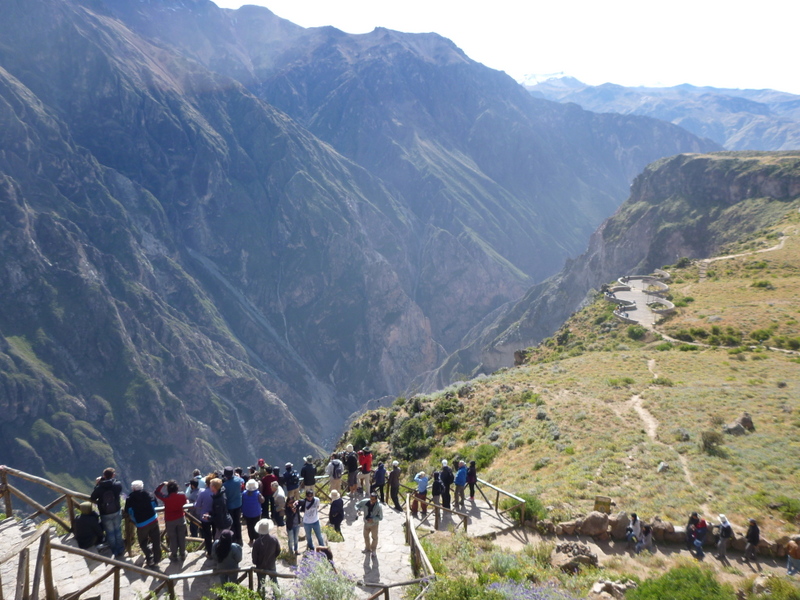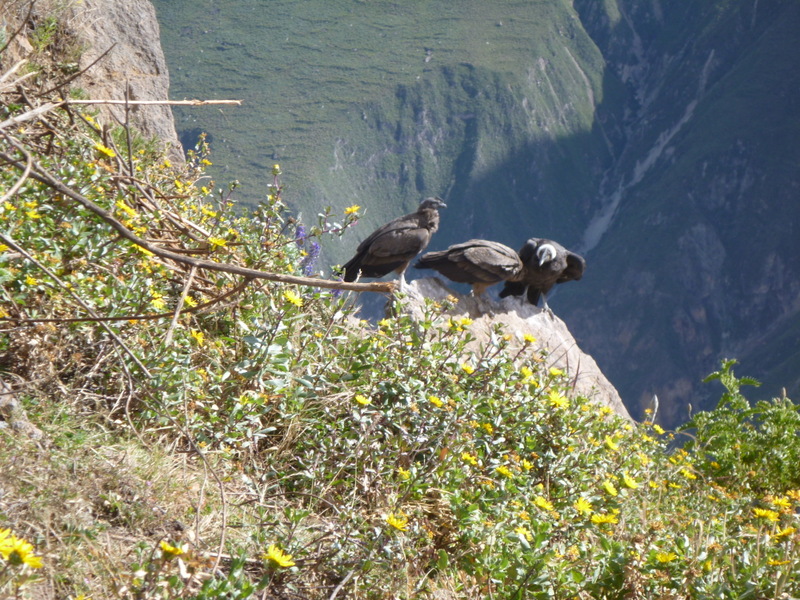After the Inca Trail and Machu Picchu, my brother Alex, our new friend from the Inca Trail, Tsvetomira, and I had six weeks of adventures together through Peru and Ecuador that included hiking the second highest canyon in the world, hiking a 19,000 ft volcano, sandboarding down giant sand dunes, partying in awesome hostels on perfect weather beaches next to the equator, trekking through the amazon, being the first clients to repel down waterfalls, and mountain biking down a four year old lava field. If you’re looking for adrenaline packed adventure and natural beauty, you won’t have to venture much further than Peru and Ecuador. Check out the highlights in Arequipa below.
Arequipa, Peru: Colca Canyon and Mt. Misti
Colca Canyon, twice as high as the Grand Canyon
When we ventured to Arequipa, we were still in the hiking mood since we had just completed the Inca Trail and found it spectacularly beautiful. While looking around for the best deal for a Colca Canyon two day tour, we saw signs for Mt. Misti and were enticed to climb it, partly because it is a little higher than Mt. Kilimanjaro, which we hiked the year before, and party because we saved 10 soles (about $4 USD) by signing up for both. We foolishly booked them back to back.
Colca Canyon started really early at 3am. The first day started with a long bus ride to the trailhead, stopping to spot some giant condors, a sacred bird to the Incas. We hiked for eight hours, almost all downhill on what looked like sheer cliffs into the second highest canyon in the world. We stopped for lunch and proceeded another few hours to Sangalle Oasis. We took our time and enjoyed the beautiful scenery.
The next morning, we awoke early again and proceeded to climb up out of the canyon. What was supposed to take four hours only took us grueling two and a half, as we challenged ourselves to make it up quickly. We recovered over breakfast, asking ourselves how we were supposed to climb a 19,000 ft volcano the next day. We bussed our way back to Arequipa, stopping along the way at a cute little village and the highest point in the road (about 15000 ft).
Mt. Misti, testing limits
Back in Arequipa, we had just enough time to eat and go back to sleep, all the while nervously joking that climbing Misti would be impossible. We had hiked four days on the Inca trail, two days in Colca Canyon, and were sleep deprived from the early mornings. Misti was supposed to be difficult hike: six hours the first day to camp, carrying all of our own heavy climbing gear followed by a 1am, six to seven hour push to the summit and decent to the bottom on the same day. Hiking would be hard enough, but the altitude makes it a whole different ball game.
We started the next morning around 7am, grabbing breakfast and then packing heavy winter climbing gear, including boot crampons and an ice axe. We took a truck up to the base of the mountain and started very slowly, as is necessary with altitude. We arrived in just four and half hours to camp at 4600 meters (15,000 ft) feeling great. Our confidence was high. We immediately ate a pasta with tomato and tuna sauce dinner and retired to our tents around 6pm to get what sleep we could.
Our alarms woke us at twelve. Already in our layered winter clothing, we ventured out to the below freezing weather for a quick breakfast. At 1am, with our headlamps, ice picks, and day packs, we started our zombie march up the mountain. Half asleep and our minds half working from lack of oxygen, in a dreamlike trance, each person followed closely the person in front with slow, methodical steps up the ever steepening slope. Constant pace is important as breaks must be kept to a minimum to avoid getting too cold.
At one point, Alex asked how long we had been hiking. I guessed 3 hours – it was only one and a half. We continued chugging along.
Two and half hours later, the there were no more rocks to hike on, only ice. We donned our ice crampons, took out our ice axes and continued hiking. One misstep and you can slide thousands of feet down to almost certain death.
Over an hour later, the sun was rising now, and we started realizing how tired we were. Our legs were sore and the altitude was getting to us, but we were too close now. We passed a large rock and saw a flag in the distance, it was the summit! Though it seemed close, it was still a good 45 minutes away. It gave us hope that there was an end.
As we reached the bottom tip of the caldera, Tsvetomira began gasping for air and bent over to the ground. She felt very sick. She sat for five minutes, warming in the sun. We also gave her some coca leaves to chew one, which helped relieve the symptoms. She got up, and we continued on.
Slowly we made our way, not turning back. And finally, we made it! After hugging and celebrating, I started taking pictures while Alex collapsed on the ground to rest. Tsvetomira, despite feeling terrible had a smile on her face. The views were absolutely gorgeous, our reward for making it.
The celebration didn’t last all that long (10 minutes), as we still had a problem. We used seemingly all our energy reaching the top, and we still had hours and hours to get all the way back down the volcano. It’s not something you consider until you’re at the top.
We proceeded, first down the ice with our crampons, then down the rocky terrain leading up to the ice. This part was painful, but at this point it was about survival. You don’t want to go on, but you know staying at altitude will only make things worse – the only way to feel better is to get down.
After an hour, we reached a giant field of loose volcanic gravel. This is where it started getting fun, as each step you took, your foot would slide down a bit more. It took some getting used to, but by putting your weight all on one foot at a time, you could slide from foot to foot, bouncing down at a quick rate. Picking up the pace to a jog almost made it feel like you were skiing. A little bit of fun and descending helped us re-energize.
We made it back to camp, took a short rest, and continued onward, feeling progressively better. The rest of the way down was slow and monotonous, but bearable considering how we felt at the top. We passed out in the van ride on the way back and slept again once we got back to Arequipa.
The climax of our South American hiking ended in triumph and our mood for hiking was over-satisfied. Our new mission was to find the beach.
If you’ve ever climbed a mountain that challenged you, how did you feel afterward? For me, climbing mountains like Kilimanjaro and Misti are a double-edged sword. I love the thrill of a challenge, pushing my limits and seeing how far I can go. The utter misery I feel pushing for the top makes it that much sweeter to reach it. For a few minutes, I’m on top of the world and feel no pain or exhaustion. After reaching the bottom, the thought of climbing another mountain is completely ridiculous. But a week or two after the climb, the memories of hardship dull and the memory at the top remains – the desire to climb another mountain slowly returns. Have you experienced something similar? Can this extend beyond climbing a literal mountain? Leave a comment here.


 I'm a travel junkie with an IT background. I backpacked around the world for 14 months creating adventures and learning. On this blog, you'll find stories and money saving travel tips that will help you make your travel dream a reality. Enjoy! Feel free to visit my social networking profiles below or my
I'm a travel junkie with an IT background. I backpacked around the world for 14 months creating adventures and learning. On this blog, you'll find stories and money saving travel tips that will help you make your travel dream a reality. Enjoy! Feel free to visit my social networking profiles below or my 



{ 3 comments… read them below or add one }
Great story! Never ceases to amaze me how you continuously do these long, difficult hikes. Keep it up!
After climbing Huayna Potosi I declared I am never doing it again because it felt like walking through endless, frozen hell….the longest day of my life. Then we climbed Misti which was horribly difficult and now I think I am ready to climb another mountain….what’s the highest mountain in New Jersey? 😉
Haha I give you credit for continuously wanting to put yourself through pain, though I know the top is worth it! I don’t think there are too many good mountains in New Jersey, but you should think about climbing Mt. Washington in New Hampshire. It’s the highest mountain in the Northeast and boasts the worlds worst weather.
{ 2 trackbacks }